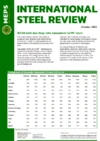As China takes a break, what is next for the global steel market?
Steel trading in China may have fallen silent ahead of the Lunar New Year festivities, but it is the global steel market that is taking a breather following a turbulent 12 months.
The influence of China, the world’s largest producer and consumer of steel, should not be underestimated. Market developments in that country are always watched with a keen eye by steel industry participants worldwide.
Following a lengthy period of growth in the second half of 2020, Chinese domestic and export prices corrected downwards, in the months prior to the vacation period.
Market confidence continues to be negatively affected by Covid-19 outbreaks. Many Chinese factories ceased operations, well in advance of the official holidays, which began on February 11. The softening in steel prices is likely to be, at least in part, a consequence of the recent reduction in activity.
Many steel market participants will be concerned, asking is this price weakness a temporary phenomenon or part of a longer-term trend?
Two schools of thought
Some Chinese observers expect the pricing deterioration to continue, in the post-holiday period, believing that domestic figures escalated “too much and too quickly”, at the end of last year. It is suggested that the recent price fall was not totally unexpected, and values are likely to reduce further before settling at a lower, but more sustainable level, for both buyers and sellers.
This scenario would be a worrying development for global steelmakers. They were undoubtedly beneficiaries of the rapid advance of Chinese domestic and export prices, in 2020. Consequently, further reductions in Chinese steel prices would pose a threat to the sustainability of the high prices that many steel mills, worldwide, can currently command.
The Chinese economy, which suffered initially from the Covid-19 outbreak, bounced back impressively, in the second half of last year. A significant amount of public funding was pledged. This gave the domestic market an increased thirst for steel. Chinese mills, keen to take advantage of the situation, prioritised local supply, at the expense of their export orders.
A significant increase in imported steel volumes was also noted in 2020. Low-cost suppliers of steel diverted material, which was typically destined for Europe or North America, into China. This in turn gave steelmakers worldwide the opportunity to raise prices in their local markets – with little resistance, owing to a shortage of supply alternatives.
However, the recent lull in Chinese activity and prices, whether for seasonal reasons or not, has given global steel manufacturers particular cause for concern.
Cheap Chinese offers
From our February research, we understand that Chinese suppliers were prepared to lower their price offers into Southeast Asia and other parts of the world. It was reported that Chinese hot rolled coil was being widely touted in the Middle East and Africa at US$700 per tonne, CIF local port, equivalent to €600 per tonne.
As a result of the increased competition posed by Chinese mills, both domestically and in their key export markets, Turkish suppliers are being more active in southern Europe. Evidently, an increase in competitively priced Chinese exports, even if not sold directly, will undermine the pricing ambitions of steelmakers in most countries.
With China’s annual steel production at around 1 billion tonnes, the global steel market will continue to be hugely exposed to the actions of the Chinese mills.
Many will be eagerly anticipating the post-holiday developments in China, and while some steel buyers anticipate further downward price pressure, other steel market participants are projecting a rebound, in the near term.
Demand to recover?
There are some grounds for optimism. Market fundamentals within China, generally, remain robust. Demand across a range of steel-consuming sectors is expected to recover. Activity in the construction industry is projected to pick up strongly, after the winter period – most notably, in the northern parts of the country. March and April are traditionally strong months for steel demand. Furthermore, inventory levels are below average. Consequently, a period of restocking activity is envisaged, in the coming months.
Belief is widespread that the Chinese authorities will introduce additional economic stimulus measures, following the Spring Festival. China was the only major economy to record positive GDP growth in 2020 – and further expansion is expected, this year. Significant investment in infrastructure within the country will help boost steel demand.
In addition, China’s Ministry of Industry and Information Technology (MIIT) has already stated its intention that domestic crude steel production, in 2021, should not exceed that of the preceding year. Measures are likely to be put in place to limit supply, for environmental reasons. Taxes on steel exports will also encourage Chinese steel mills to focus their attention on domestic affairs and, in turn, make less material available for shipment overseas.
MEPS analysts conclude that a large degree of uncertainty persists about conditions in the Chinese steel market, in the post-Lunar New Year period. The future pace and direction of price movements continue to divide opinion among regional and global steel buyers and sellers.
It is highly likely that the Year of the Ox will be an interesting one for all those concerned in the global steel scene. No-one will be immune from the repercussions of developments in the world’s biggest, and most influential, steel market.

Source:
International Steel Review
The MEPS International Steel Review is an essential monthly publication, offering professional analysis and insight into carbon steel prices around the world.
Go to productRequest a free publication





